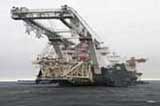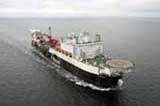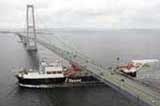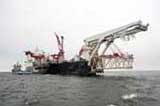
Pipe Laying Vessel - Solitaire
Pipe laying of the 1,224 kilometre long Nord Stream Pipeline started in April 2010. Three pipe-laying barges were commissioned to work on the project.
- Saipem's Castoro Sei - for the majority of the route in the Baltic Sea
- Saipem's Castoro Dieci - for the shallow waters in Germany
- Allseas Solitaire - for pipe laying in the Gulf of Finland
Solitaire is the largest pipelaying vessel in the world and has set new standards in the pipelay industry. Operational since 1998 and optimised for laying medium and large diameter pipelines at high speed, she is highly competitive for pipelay projects anywhere in the world.
Precise manoeuvring on full dynamic positioning (DP) allows Solitaire to work safely in congested areas and lay pipes in very deep water. Pipeline start-ups and lay-downs are executed in very quick time ensuring that any disruption to other activities near platforms is minimised.
Due to her length and ship shape, she can accommodate multiple work stations and a greater pipe hold capacity, while her independence from anchor handlers and large buffer capacity ensure she is less reliant on offshore pipe supply.
Solitaire has achieved pipelay speeds in excess of 9 km/day, operating the latest version of Phoenix, the automatic welding system developed and manufactured in-house.
As a result of the large number of welding stations on board, Solitaire is capable of installing over 1,000 km of pipeline in a single year, while her average pipelaying speed on large projects is almost double that of the largest competing lay vessels.
Solitaire has laid numerous deepwater pipelines. In 2007 she set the world record for ultra-deepwater pipeline installation, laying pipe to a depth of 2,775 m (9,100 ft) in the Gulf of Mexico. Solitaire's high cruising speed, high laying speed and substantial carrying capacity make her highly competitive for pipelay projects anywhere in the world.
Images Pipe Laying Vessel Allseas Solitaire
General characteristics Solitaire
- Length overall (incl. stinger) 397m
- Length overall (excl. stinger) 300m
- Length between perpendiculars 249m
- Breadth 41m
- Maximum speed 13 knots
- Total installed power 51,500 kW
- Accommodation 420 persons
- Dynamic positioning system LR DP (AAA), fully redundant Kongsberg K-Pos DP-22, K-Pos DP-12 and 3 x cJoy system
- Deck cranes 2 x Pipe transfer cranes of 34t at 33m
1 x Special purpose crane of 300t at 17m
1 x PLET installation frame of 400t
- Work stations 2 x Double joint factories, each with 3 welding stations and 1 NDT station. Main firing line with 5 welding stations for double joints, 1 NDT station and 4 coating stations.
- Tensioner capacity 3 x 350t at 30 m/min (98 ft/min)
- Pipe diameters From 2 to 60in OD
- Pipe hold capacity 22,000t
Reference(s) for the images and text, is owned by Nord Stream AG Allseas
Pipe laying Methods
The most common installation methods are the S-Lay, J-Lay, and Reel-Lay methods.
In the S-Lay method, as the laying barge moves forward, the pipe is eased off the stern, curving downward through the water until it reaches the touchdown point. After touchdown, as more pipe is played out, it assumes the "S" shaped curve. To reduce bending stress in the pipe, a stinger is used to support the pipe as it leaves the barge. To avoid buckling of the pipe, a tensioner must be used to provide appropriate tensile load to the pipeline (Clauss,1998). This method is used for pipeline installations in a range of water depths from shallow to deep.
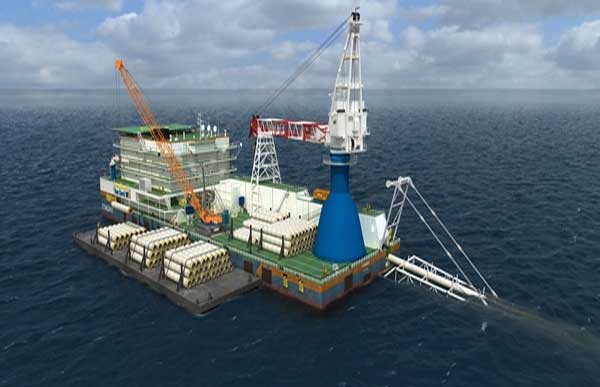 van Oord's Stingray uses the S-Lay method
van Oord's Stingray uses the S-Lay method
In the J-lay method, the pipe is dropped down almost vertically until it reaches touchdown; after that it assumes the "J" shaped curve. J-Lay barges have a tall tower on the stern to weld and slip prewelded pipe sections. With the simpler pipeline shape, the J-Lay method avoids some of the difficulties of S-Laying such as tensile load forward thrust, and can be used in deeper waters.
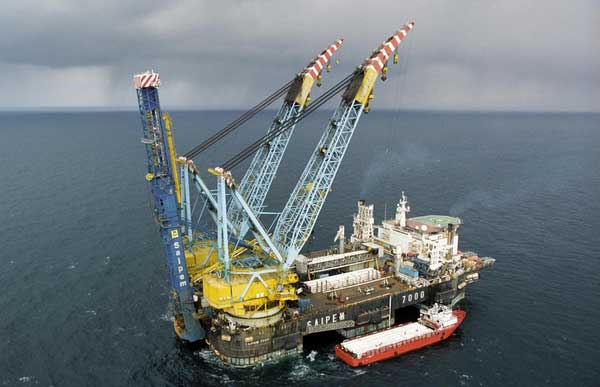 Saipem's 7000 barge uses the J-Lay method
Saipem's 7000 barge uses the J-Lay method
In the Reel-Lay method, the pipeline is installed from a huge reel mounted on an offshore vessel. Pipelines are assembled at an onshore spool-base facility and spooled onto a reel which is mounted on the deck of a pipelay barge. Horizontal reels lay pipe with an S-Lay configuration. Vertical reels most commonly do J-Lay, but can also S-Lay.
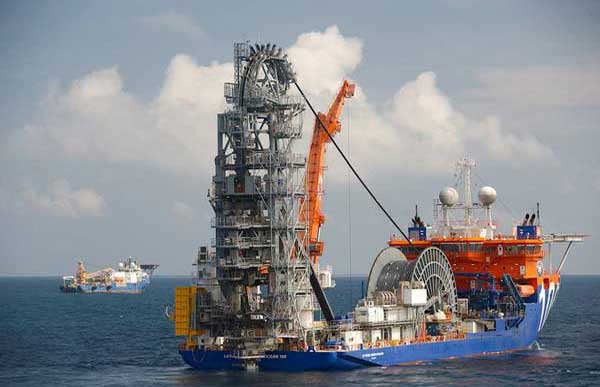 McDermott's North Ocean 105 uses the Reel-Lay method
McDermott's North Ocean 105 uses the Reel-Lay method